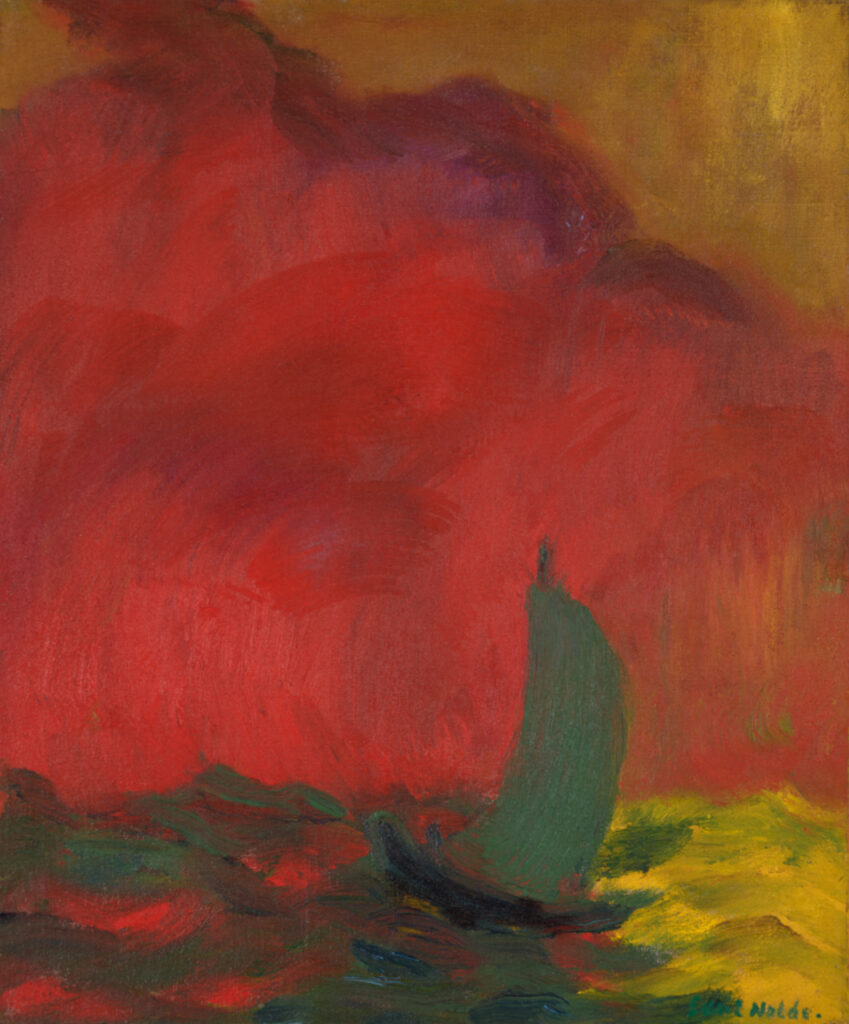Fischkutter (Rotter Himmel) Fishing Boat (Red Sky) (work of art)
Artwork Info
Key Ideas about this Work of Art
- This is an expressionist painting. Expressionism is a style of art that was intended to communicate the artist’s emotions rather than depict something lifelike.
- Emil Nolde was a German expressionist artist known for his brushwork and use of color. He was part of a group of German artists who helped create expressionism as an art style.
- Nolde painted many scenes of rough waters after his experience crossing a long waterway between Sweden and Denmark. The “rough waters” motif was a recurring theme in his paintings.
- Nolde was an anti-Semite (a person who is hostile toward or prejudiced against Jewish people) and a supporter of the Nazi party.
- The Nazi party considered all modern art to be “degenerate” (or ”un-German”), and they especially disapproved of expressionist art. Even though Nolde supported the Nazis, his work was removed from museums and he was forbidden by the Nazis to paint during World War II.
Learn More
This painting was inspired by the artist’s memory of a terrifying trip crossing the Kattegat (a waterway between Sweden and Denmark) around 1910. “This day,” he explained, “has remained so fixed in my memory, that for years afterwards all my paintings of the sea consisted of wildly heaving green waves and only a little edge of yellow sky on the upper fringe.”
Emil Nolde was a German artist and one of the first expressionist painters. He is best known for his expressive color choices. His work communicates his emotions rather than depicting realistic-looking scenes. Nolde’s heavy brushwork and use of color in this painting communicates how he felt in a moment at sea when he feared for his life. The experience affected him so deeply that “rough waters” became a recurring theme in his paintings. This is one of many works he created based on that event.
A group of German artists known as Die Brücke (translated “The Bridge”) admired Nolde’s style and invited him to join their group. Die Brücke played an important role in the evolution of modern art and in the creation of expressionism in the 20th century. Nolde left the group after a year and a half, and the remaining members moved to Berlin around 1911.
Nolde was an anti-Semite and supporter of the Nazis. Because Adolf Hitler rejected all forms of modern art as “degenerate,” the Nazi party officially condemned Nolde’s work. They featured his work in the Degenerate Art exhibition in 1937. This Nazi exhibition intended to shame what they considered “bad art,” which was mostly modern work. The Nazi party strongly disapproved of expressionist art. More than 1,000 of Nolde’s works were removed from German museums. He was forbidden to produce any paintings during World War II.
Additional Resources
Resources for Teachers
- Read the artist’s biography.
- Read an article about Die Brücke.
- Read an article about the Degenerate Art exhibition.
Resources for Students
- Watch a video about the Degenerate Art exhibition.
- Watch a video about Nolde’s life and work.
- Visit a website to view works of art made by the artist group Die Brücke.

